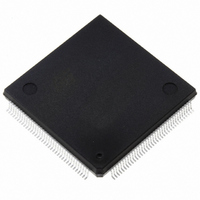ST10F269Z2Q6 STMicroelectronics, ST10F269Z2Q6 Datasheet - Page 33

ST10F269Z2Q6
Manufacturer Part Number
ST10F269Z2Q6
Description
MCU 16BIT 256K FLASH 144PQFP
Manufacturer
STMicroelectronics
Series
ST10r
Specifications of ST10F269Z2Q6
Core Processor
ST10
Core Size
16-Bit
Speed
40MHz
Connectivity
CAN, EBI/EMI, SSC, UART/USART
Peripherals
POR, PWM, WDT
Number Of I /o
111
Program Memory Size
256KB (256K x 8)
Program Memory Type
FLASH
Ram Size
12K x 8
Voltage - Supply (vcc/vdd)
4.5 V ~ 5.5 V
Data Converters
A/D 16x10b
Oscillator Type
Internal
Operating Temperature
-40°C ~ 85°C
Package / Case
144-QFP
Controller Family/series
ST10
No. Of I/o's
111
Ram Memory Size
12KB
Cpu Speed
40MHz
No. Of Timers
5
Embedded Interface Type
CAN, SSC, USART
Rohs Compliant
Yes
Processor Series
ST10F26x
Core
ST10
Data Bus Width
16 bit
Data Ram Size
12 KB
Interface Type
CAN, SSC, USART
Maximum Clock Frequency
40 MHz
Number Of Programmable I/os
111
Number Of Timers
2 x 16 bit
Operating Supply Voltage
0.3 V to 4 V
Maximum Operating Temperature
+ 85 C
Mounting Style
SMD/SMT
Minimum Operating Temperature
- 40 C
On-chip Adc
16 bit x 10 bit
Lead Free Status / RoHS Status
Lead free / RoHS Compliant
Eeprom Size
-
Lead Free Status / Rohs Status
Details
Other names
497-4833
Available stocks
Company
Part Number
Manufacturer
Quantity
Price
Company:
Part Number:
ST10F269Z2Q6
Manufacturer:
ST
Quantity:
201
Company:
Part Number:
ST10F269Z2Q6
Manufacturer:
ST
Quantity:
745
Company:
Part Number:
ST10F269Z2Q6
Manufacturer:
STMicroelectronics
Quantity:
10 000
Part Number:
ST10F269Z2Q6
Manufacturer:
ST
Quantity:
20 000
5.6.5 - Choosing the Baud Rate for the BSL
The calculation of the serial Baud rate for ASC0
from the length of the first zero Byte that is
received, allows the operation of the bootstrap
loader of the ST10F269-T3 with a wide range of
Baud rates. However, the upper and lower limits
have to be kept, in order to insure proper data
transfer.
The ST10F269-T3 uses timer T6 to measure the
length of the initial zero Byte. The quantization
uncertainty of this measurement implies the first
deviation from the real Baud rate, the next
deviation is implied by the computation of the
S0BRL reload value from the timer contents. The
formula below shows the association:
For a correct data transfer from the host to the
ST10F269-T3 the maximum deviation between
the internal initialized Baud rate for ASC0 and the
real Baud rate of the host should be below 2.5%.
The deviation (F
rate and ST10F269-T3 Baud rate can be
calculated via the formula below:
Figure 8 : Baud Rate Deviation Between Host and ST10F269-T3
S0BRL
2.5%
F B
B
F B 2.5
ST10F269-T3
=
B
≤
F
Low
B
=
B Contr B Host
------------------------------------------- -
T6 36
------------------- -
%
B
72
B
, in percent) between host Baud
–
Contr
=
–
------------------------------------------------ -
32
,
×
(
T6
S0BRL
f
CPU
×
B
=
High
100
9
-- -
4
×
+
% ,
-----------------
B Host
1
f
CPU
)
I
II
Note: Function (F
This Baud rate deviation is a nonlinear function
depending on the CPU clock and the Baud rate of
the host. The maxima of the function (F
increase with the host Baud rate due to the
smaller Baud rate pre-scaler factors and the
implied higher quantization error (see Figure 8).
The minimum Baud rate (B
determined by the maximum count capacity of
timer T6, when measuring the zero Byte, and it
depends on the CPU clock. Using the maximum
T6 count 2
rate can be calculated. The lowest standard Baud
rate in this case would be 1200 Baud. Baud rates
below B
case ASC0 cannot be initialized properly.
The maximum Baud rate (B
is the highest Baud rate where the deviation still
does not exceed the limit, so all Baud rates
between B
limit. The maximum standard Baud rate that fulfills
this requirement is 19200 Baud.
Higher Baud rates, however, may be used as
long as the actual deviation does not exceed the
limit. A certain Baud rate (marked ’I’ in Figure 8)
may violate the deviation limit, while an even
higher Baud rate (marked ’II’ in Figure 8) stays
very well below it. This depends on the host
interface.
tolerances of oscillators and other devices
supporting the serial communication.
Low
Low
16
would cause T6 to overflow. In this
in the formula the minimum Baud
and B
B
) does not consider the
High
are below the deviation
Low
High
in the Figure 8) is
ST10F269-T3
in the Figure 8)
B
HOST
33/162
B
)













